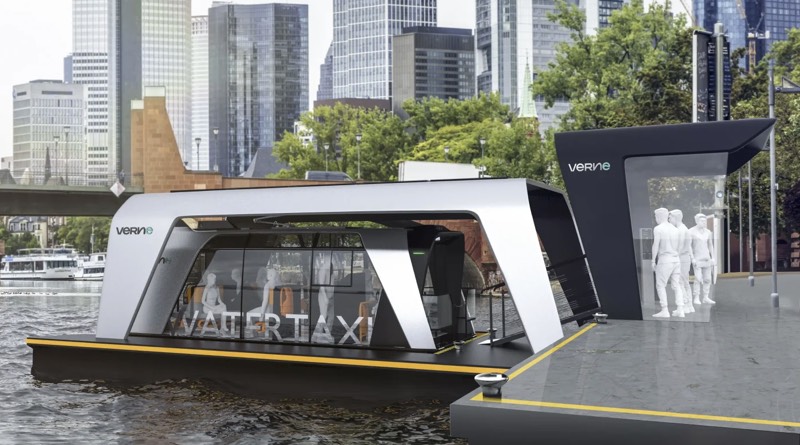AI the ‘brains’ behind autonomous electric water taxi
If Verne mobility’s vision to overhaul transport on urban waterways comes to fruition, autonomous electric water taxis and shuttles will be quietly and efficiently moving people and goods from shore to shore as buses, trucks, delivery vans and cars watch helplessly from riverside traffic jams.
Passengers or small cargo
The company’s website says that the cost of road transportation increased by 13% in 2022, and that 3 years of a city dweller’s life is spent sitting in traffic. Verne’s goal is to alleviate those and other urban problems, like the health consequences of diesel-fumed air, by delivering electric ASVs (Autonomous Surface Vehicles) driven by AI software.
At the heart of the concept is a catamaran hull 7.5 meter (24 ft) long, 3.2 meters (1.5 ft) wide with an airy 2.5 meter (8 ft) top that can be adapted and customized for either passengers or cargo. It has a 50 kW (≈65 hp) electric motor from MPower Technologies, thrusters, and rapid charging capabilities.

AI pays a big part in the scheduling aspect, whether that be for passengers or cargo. The goal is to have multiple stations along riverbanks in a city like Amsterdam or Bangkok, which allows for quick route adjustments and demand flexibility to ensure an almost ‘just-in-time’ system where people never wait more than a few minutes for the next departure.
The cargo carrying possibilities are a boon for delivery services that cannot afford to have vehicles sitting still in traffic as more and more small items are delivered to customer doorsteps.
Many cost efficiencies
The Artificial Intelligence is also essential for the autonomous aspects of the Verne fleet. Advanced LIDAR radars and other perception sensors feed data to a central decision-making algorithm, which learns more every time each vessel is out on the water on any of the routes and improves the efficiency and safety for all boats.
All of this contributes to cost efficiencies as well. With reduced energy consumption, shorter travel times, and optimized operations, the system provides a sustainable and affordable transportation solution for both operators and passengers.
Unlike many other systems, the Verne idea is a modular approach. Whether owned and operated by private companies or municipal governments, Verne can start with just one shuttle and be built from there with more stations and more vessels as demand requires.

Company Co-Founder Sławomir J. Chodor says Verne gives businesses “a new opportunity to put in place an innovative mobility water transport platform that can kickstart the new business opportunity in alternative fuels for shipping.”
Huge electric water taxi market
Whether it be the Verne solution or another, urban water transport is a huge and growing opportunity for electric vessels. Hydrofoiling pioneer Candela launched the first of their P-12 water taxis last fall in Stockholm with a P-12 line to be operational in the city’s local transport system later in 2024.
Also in Stockholm, Zeabuz launched the world’s first commercial autonomous passenger ferry, last June. Lisbon has the first of a planned 10 electric passengers ferries in operation. In Bangkok, Torqeedo electric motors power a fleet of river commuter boats.
Read about all the electric ferries Plugboats has covered
Artemis Technologies of Ireland, winner of the 2023 Gussie Electric Boat Awards for Commercial Passenger Passenger Vessels is getting ready to launch their EF-24 high-speed hydrofoiling e-ferry in 2024. The 2022 Gussies winner, Kochi Metro, will soon have 78 electrified vessels serving the city in India.
Cities need new solutions, and companies like Verne are ready and eager to help. As Chodor says, “”I hope this proposal will act as a bridge between the climate ambitions of both developed and developing cities, so that no part of the global waterborne cities mobility industry will be left behind.”


